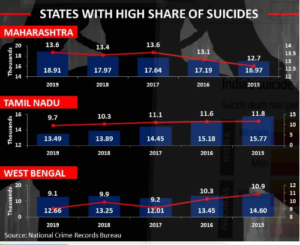In news
WHO has published Suicide worldwide in 2019 report recently
About the report
- The report is part of WHO’s Global Health Estimates which provide a comprehensive and comparable assessment of mortality (including suicide) and loss of health due to diseases and injuries for all regions of the world.
- World Health Statistics bring together available data on health-related Sustainable Development Goals (SDG) indicators, including suicide (indicator 3.4.2) estimates from the WHO Global Health Estimates.
- The latest WHO assessment of deaths by cause is for the years 2000–2019.
On SDGs
- Reducing the global suicide mortality rate by a third is both, an indicator and a target (the only one for mental health) in the United Nations-mandated Sustainable Development Goals (SDGs).
- But the world will not be able to reach this target if a new report by the WHO is to be believed.
- The SDGs call on countries to reduce premature mortality from non-communicable diseases by a third, by 2030 through prevention and treatment and to promote mental health and well-being (target 3.4, indicator 3.4.2).
Key highlights
- As per the report, suicide is a global phenomenon; in fact, 77% of suicides occurred in low- and middle-income countries in 2019.
- Suicide accounted for 1.3% of all deaths worldwide, making it the 17th leading cause of death in 2019.
- More than 700 000 people die by suicide every year, which is one person every 40 seconds.
- More than half of global suicides (58 per cent) occurred before the age of 50 years.
- Suicide is the fourth leading cause of death in 15-19-year-olds.
- Ingestion of pesticide, hanging and firearms are among the most common methods of suicide globally.
- On an average, 9 out of every 100,000 people ended their lives in the world.

Regional epidemiology of Suicide
- Africa(11.2), Europe(10.5) and South-East Asia(10.2) recorded suicide rates higher than the global average.
- The report found that in 20 years (2000-2019), the global suicide rate had decreased by 36 per cent.
- The decrease ranged from 17 per cent in the Eastern Mediterranean Region to 47 per cent in the European Region and 49 per cent in the Western Pacific Region.
- The Region of the Americas recorded a substantial 17 per cent increase in the suicide rate during the same period and has been an exception.
- According to the report, only 38 countries are known to have a national suicide prevention strategy.
Suicide case in India

Government of India’s initiatives
- Mental Healthcare Act, 2017
- KIRAN- Ministry of Social Justice and Empowerment
- Manodarpan by Ministry of Education
WHO guidelines to prevent suicide
The WHO had published new LIVE LIFE guidelines to help countries reduce the global suicide mortality rate by a third by 2030. These are:
- Limiting access to the means of suicide, such as highly hazardous pesticides and firearms.
- Educating the media on responsible reporting of suicide.
- Fostering socio-emotional life skills in adolescents.
- Early identification, assessment, management and follow-up of anyone affected by suicidal thoughts and behaviour.
As per the WHO report, these needed to go hand-in-hand with foundational pillars like situation analysis, multi-sectoral collaboration, awareness raising capacity building, financing, surveillance and monitoring and evaluation. WHO Mental Health Action Plan 2013–2020 now extended to 2030.
















